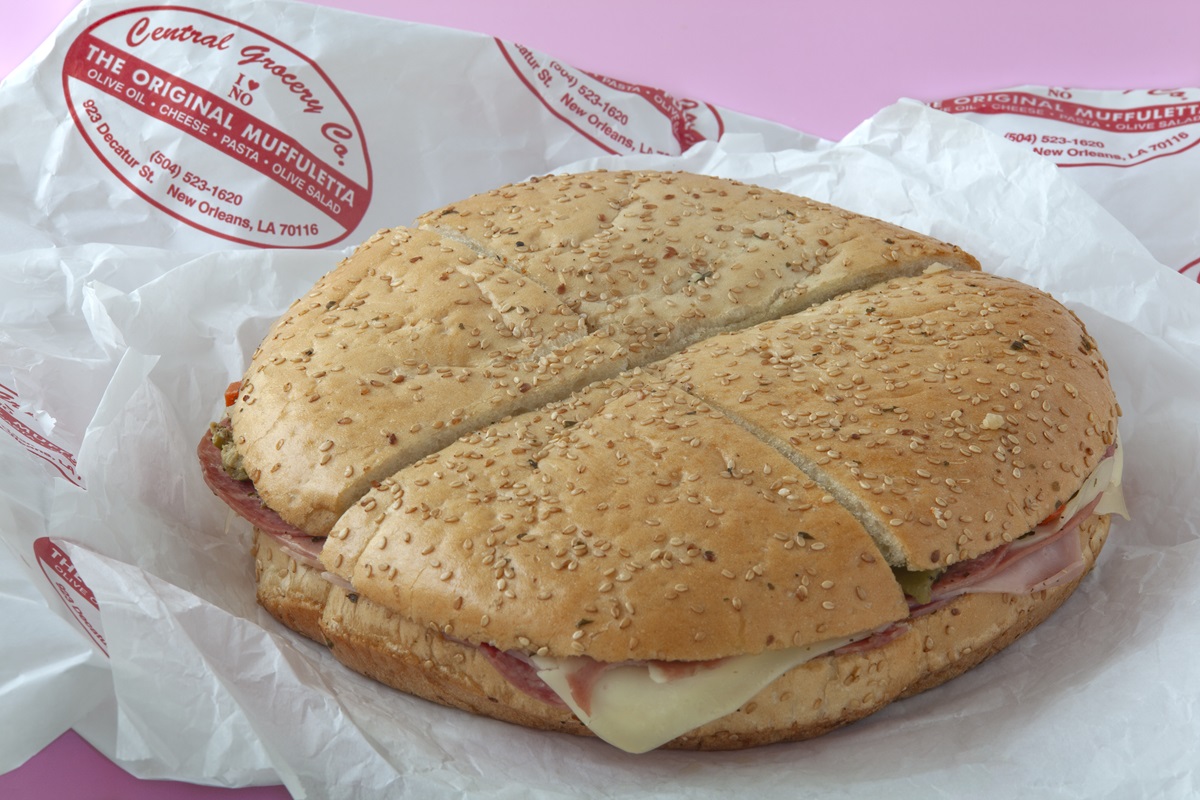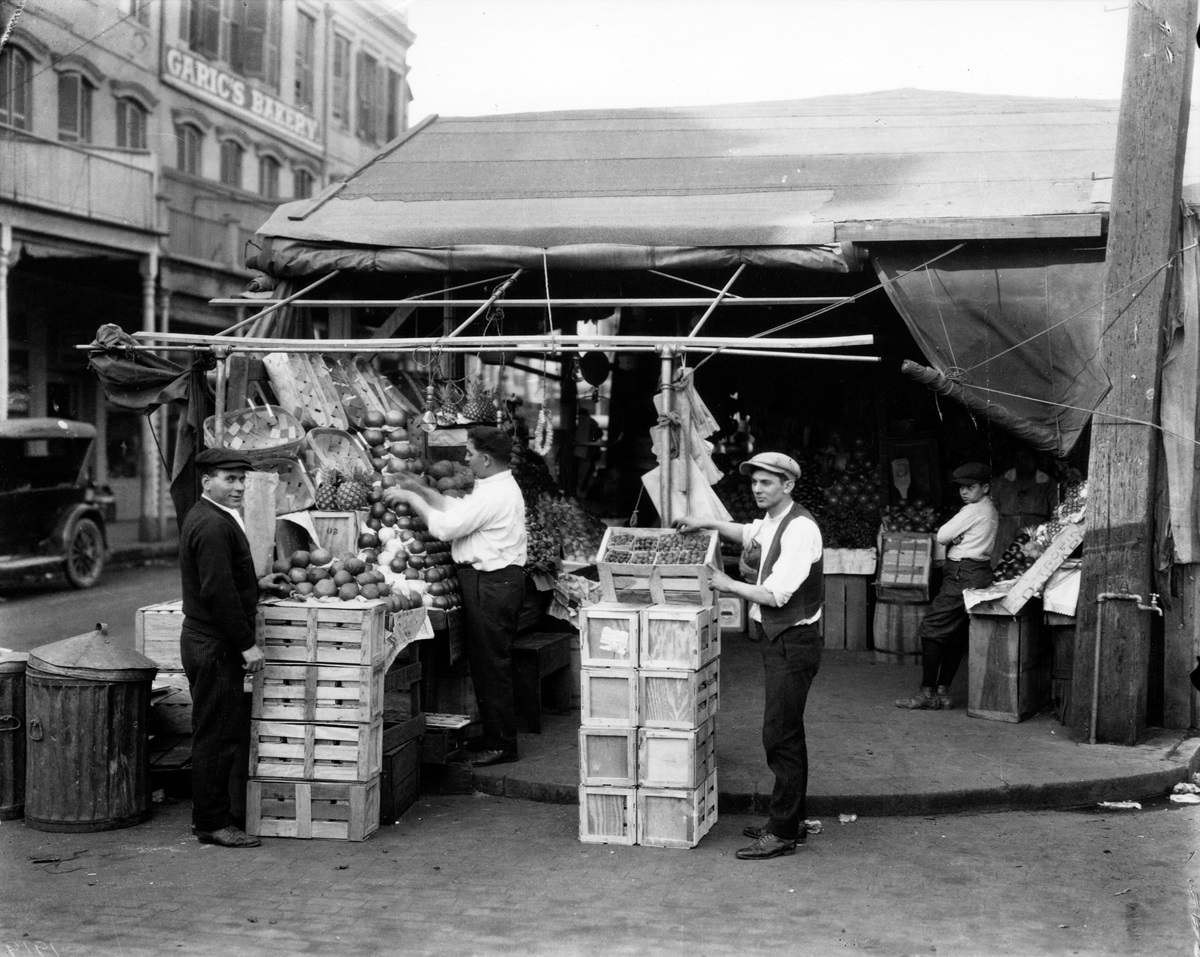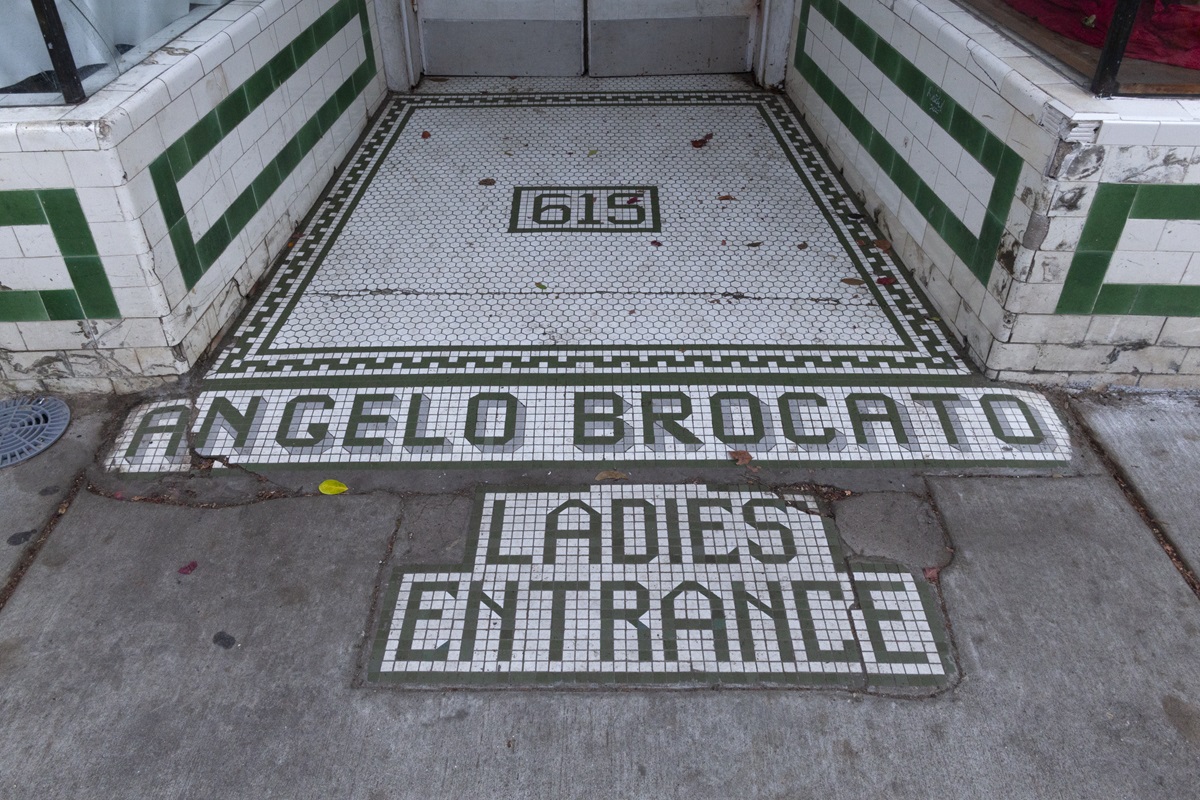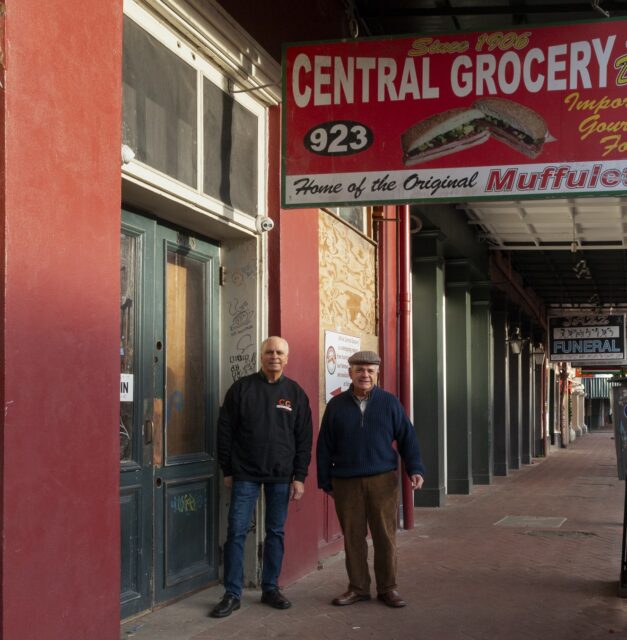A Century of Garlic and Olives
The life, death, and rebirth of Central Grocery
Published: February 29, 2024
Last Updated: June 1, 2024

Photo by Melissa Carrier
A Central Grocery muffuletta.
No shelves filled with old-world specialties. No tins of olive oil or barrel of olive salad. No tourists, no locals, no one lining up for the sandwich, made in-house, that put this Decatur Street business on the map of iconic New Orleans locales more than one hundred years ago. The last day Central Grocery sold one of their famous muffulettas in-house was August 27, 2021—two days before Hurricane Ida devastated the city. The check-out counter and sandwich-making station: warped, unsalvageable after the dayslong torrent of rain that cascaded into the building, which was reduced to just “four brick walls and a cement floor,” according to co-owner Tommy Tusa, whose family has managed the business for three generations. A neighboring wall had come crashing down in the storm’s winds. After evacuating to Mississippi, Tusa returned to New Orleans three days following the storm. “I saw water coming out the front door,” he said. “I went in and there was water everywhere.” Tusa dashed toward the source, headed for an upstairs storage room. “When I got to the top [of the stairs],” he recalled, “all I could see was blue sky.”
Even Tusa’s grandfather Salvatore Lupo never saw the building so completely gutted. Lupo took over the location in 1919; it had been a series of Croatian-owned groceries since at least the turn of the century. There wouldn’t have been a better storefront in the city to sell kitchen staples and sundries than 923 Decatur Street. Directly across from the corner gateway of the French Market, Lupo’s Central Market stood at the very heart of what became known as New Orleans’s “Italian Colony” or “Little Palermo,” a French Quarter district that housed thousands of Sicilian immigrants, comprising more than half the Quarter’s residents.Over a quarter of a million Italians poured through the port of New Orleans between 1884 and 1924, first as conscripted laborers on post-emancipation plantations, then to escape poverty in Italy and join family and make a living abroad. By 1900 New Orleans’s population had shifted from the French Quarter center to the periphery of the city’s faubourgs. The residences left behind, especially in the lower Quarter, could be cheaply rented and easily converted into tenements. It also helped that the local order of Ursuline nuns owned properties up and down Decatur Street, where most everything a new arrival from Sicily needed—a Catholic church, intimate community, and familiar foods—was within shouting distance of your front door.
As in the old country, much of neighborhood life revolved around eating. A “spaghetti district,” in the words of a Daily Picayune reporter in 1912, spanned the lower Quarter—from Canal to Esplanade, Bourbon to the river. By 1902, the year Salvatore Lupo immigrated to New Orleans from Palermo, the French Quarter had more than a half dozen pasta factories owned and operated by Sicilians, including Giacomo Cusimano’s electric-powered plant, capable of producing ten thousand pounds per day. There were Sicilian bakeries, pastry shops, and at least one gelateria: Angelo Brocato’s. Blue-collar lunch houses doubled as seafood and spaghetti houses, a blend that would become known as Creole Italian cuisine.

Fruit and vegetable vendors at the French Market between 1914 and 1919. Charles L. Franck Studio Collection, The Historic New Orleans Collection.
Sicilian farmers cornered the French Market produce trade, transporting fruits and vegetables from truck farms along the city’s outskirts. According to Loyola history professor Justin Nystrom’s invaluable Creole Italian: Sicilian Immigrants and the Shaping of New Orleans Food Culture, Lupo apprenticed with an established grocer family, the Macaluso brothers, before partnering with Gaetano DeMajo to rent their own storefront at 1001 Decatur, at the corner of St. Philip, in 1906. They called it Progress Grocery. In 1919 Lupo and DeMajo renamed their store Central Grocery—or La Centrale, as some called it in Italian—after moving the business a block down Decatur and a block closer to the French Market’s mercantile hub.
Independent, Sicilian-owned groceries, many doubling as delicatessens, dotted the streets surrounding the market. The 900 block of Decatur contained at least three, with Lupo’s sandwiched between Messina’s Food Mart and Progress Grocery, an unrelated business opened by the Perrone family in 1924. Up on St. Philip, Biaggio Montalbano filled his eponymous deli, which he nicknamed the “Angel of Peace,” with so many devotional candles that customers still remembered, decades later, the smoke plumes rendering the air difficult to breathe.
At Central Grocery, garlic rope garlands hung above burlap bags brimming with favas, lentils, and chickpeas. Great big barrels of tomato paste—no squeezable tubes back then—stood ready for ladling. Imported boxes of Sicilian babbalucci and baccalà (snails and dried codfish) shared space with Russian caviar and Korean clams. On the counter perched a three-foot high jar of antipasto, a pickled relic altar display.
But the French Quarter’s Italian Colony would be short-lived. Starting in the 1920s, economically mobile Sicilian families begun moving up Esplanade Avenue to the Broad Street and Gentilly neighborhoods. A generation later they would begin crossing parish lines to the suburbs. The number of Sicilian businesses in the Quarter dropped dramatically over the subsequent decades. Some relocated. Most shuttered their doors forever.
Around this time, someone—perhaps Lupo himself—dreamt up the muffuletta. Culinary origin stories are often difficult to prove, but it’s hard to find a more compelling tale than the one his eldest daughter Marie Teresa recited to countless customers, as well as in interviews and her own self-published cookbook, Marie’s Melting Pot. French Market Sicilian vendors, as the story goes, congregated at Lupo’s for lunch, where they ordered trays of salami, ham, and cheese, a few spoonfuls of olive salad, and a wedge of bread. The grocery lacked tables and chairs, so the diners settled for seats amid the barrels and crates, precariously balancing their lunch trays on their knees. Lupo, whom everyone called “Toto,” a common Sicilian diminutive for Salvatore, eventually offered to stuff all the ingredients inside a sliced muffuletta loaf. Soft and sesame-seeded, round and flat, the muffuletta, a common Sicilian bread likely named for the mushroom cap, or muffe, it resembles, seemed custom made for sandwiches.
When Central reopens, the store may well feel very different. You can rebuild a roof, but how do you replace the patina of time? Preserve those aromatic layers of history, a century of garlic and olives?
Even if Central Grocery didn’t invent the muffuletta—pronounced by the Lupo Tusas as “letta” not “lotta”—the family business would forever be linked to the sandwich. “Imitated by many,” their slogan, coined by DeMajo, trumpeted, “but never duplicated.”
Indeed, the muffuletta proliferated across the city like, well, mushrooms. Most every sandwich maker in town, Italian or not, had a muffuletta on their menu, while Central Grocery’s deli counter stuck with a muffuletta-only policy. Montalbano’s marketed the Roma sandwich, a slight variation on the muffuletta that allowed customers to design their own stack of olive salad-topped meats and cheeses—perhaps some mortadella and prosciutto; sub out the provolone for mozzarella—and pay by the pound. A 1955 Times-Picayune article touted a new Lakeview restaurant specializing in “Italian po-boys and pizza snacks” and informed readers that muffulettas—likely those same Italian po-boys—are sliced “like a pie.” In the 1970s, the local Canal Villere grocery chain advertised half a sandwich, alternatively spelled “muffalatta” and “muffalata,” priced at $1.49. But New Orleanians still needed help understanding the sandwich, which the Times-Picayune described, in 1972, as an “Italian poor boy dressed with Italian salad.” (It’s not happenstance that the muffuletta arose at the same time and place as the city’s other quintessential hometown sandwich, the po-boy, whose popular origin story places its beginnings at Benny and Clovis Martin’s French Market cafe in 1929. Both were cheap, filling, portable meals fit for blue-collar workers.)
Soon the muffuletta was on the move. In 1981 the New York Times publicized a ten-night Caribbean cruise hosted by Carol Brock, a party-planning guru who would demonstrate the preparation of the “exotic concoction” known as the muffuletta. Schlotzsky’s transformed from a modest Austin, Texas, lunch counter to a 700-outlet fast-food behemoth thanks to a sandwich they called The Original modeled after, you guessed it, New Orleans’s muffuletta.

Signage for one of two entrances to the original Angelo Brocato’s location on Ursulines Street. The café is now Croissant d’Or. Photo by Melissa Carrier.
Despite its ubiquity, the muffuletta became increasingly synonymous with Decatur’s 900 block, where Central, along with Progress and another deli named Frank’s, centered a mini muffuletta district by the time Salvatore “Tommy” Tusa stepped into his grandfather’s shoes in 1970 (Tusa’s father Frank co-managed the store after Salvatore Lupo passed in 1957). The new decade marked an inauspicious time on Decatur. The previous year, widespread opposition canceled the proposed Vieux Carré Riverfront Expressway, a partially elevated federal monstrosity that would have buried Central Grocery under a smattering of massive concrete pilings that instead overtook Claiborne Avenue. With Decatur saved from erasure, city officials used the occasion to turn the street into a vehicular thoroughfare anyway, eliminating parking spots from most blocks. Freight trucks couldn’t make deliveries. Local customers abandoned the lower Quarter, yet continued to support Central, accounting for 85 percent of the grocery’s business in the early 1970s in Tusa’s estimation.
Then came the hippies and bikers, who, inspired by the 1969 blockbuster film Easy Rider, descended upon the South’s sin city, and especially easy, sleazy Decatur Street, in droves. Some businesses aptly responded to the pot-smoking, sidewalk-dozing rabble: more French Market stalls stocked tourist schlock, and Goldberg’s clothing store, 925 Decatur, stacked their racks with mod fashion. Many others floundered. Tujague’s began closing on Mardi Gras Day after a throng of flower children crowded the restaurant’s bathrooms without spending a dime. Morning Call decamped to the suburbs in 1974. “The young people who took a fancy to the street,” according to one “matronly Quarterite” quoted in a 1972 Times-Picayune exposé, have even “driven the ‘fancy ladies’ [or prostitutes] away.”
The parking debacle decimated what remained of Decatur’s Italian Colony. LaNasa’s Hardware, open for eighty-five years, went belly up. Receipts at Sam Greco’s Grocery, open since 1913 on the corner of Decatur and Barracks, plummeted 25 percent—it, too, soon disappeared. Brocato’s moved to Mid-City in 1981. It’s safe to say the muffuletta saved Central Grocery, which by now was selling thousands of sandwiches a day. Tusa calculates that the local-to-tourist ratio has reversed since he took over in 1970; the latter now accounts for 85 percent of Central’s business.
I should confess that though I lived just down Decatur until this past summer, not a ten-minute walk away, I hadn’t set foot inside Central Grocery since 2017, when a former college roommate dragged me down the street for a muffuletta. As far as I was concerned, standing in a line of tourists was anathema; I’d rather drive to Nor Joe in Metairie or DiMartino’s in Marrero to sate a muffuletta craving. Eventually I became a vegetarian, but retained an allegiance to Central’s olive salad, for sale at most area supermarkets, which I spoon on top of salads, crackers, and directly into my mouth.I might not be a devotee. But I can readily conjure up a Central Grocery muffuletta I ate in the hazy post–Hurricane Katrina months—a period about which I otherwise remember very little. I was sitting on the Mississippi River Moon Walk, I can recall the sensation of running my olive oil–slicked hands back and forth over the grass and rocks of the levee. Was I out of napkins, or did I just want to feel the ground beneath me, reassurance that this— these grass, rocks, soil—did not, will not wash away?
Central Grocery reopened on December 1 following Katrina, losing just three months of business. In an interview a decade later, Tommy Tusa recalled discussing whether to unload the business. At least one family member wanted out. His position remained steadfast: “No way. [I would] never sell this business, not as long as I’m alive.”

Co-owners Tommy and Frank Tusa. Photo by Melissa Carrier.
Hurricane Ida shut down Central Grocery for over two years. Tusa had, between storms, settled into a relaxing, pre-retirement rhythm. He’d clock in two, three days a week, relying on a pair of managers to run the store along with his cousin and co-owner Frank Tusa. “I was finally enjoying the business because I put all the headaches on them,” he told me with a laugh, “and then Hurricane Ida came along and changed all that.”
One questions why Tusa, at seventy-two years old, wouldn’t rather cash out and walk away. Even if he offloads many of the headaches of operating a tourist-driven restaurant in a tourist-dependent city that seemingly exists one hurricane away from ruin, running Central Grocery comes with its own special migraines.
There’s the never-ending parking woes. “Let’s face it, we lost a lot of the local business [during the Ida-forced closure],” he said. “You’re not coming from Metairie to get a forty-dollar parking ticket to buy a sandwich.” Over the past two years, Central Grocery, smartly, made its location all but obsolete. Eaters can now procure a Central Grocery muffuletta—ham, salami, mortadella, Swiss, provolone, and their secret olive salad blend—from just about everywhere: groceries across the metro area, the airport, and even shipped nationwide via Goldbelly—all made in a commissary located in Kenner.
But it’s not just parking problems, Tusa fears, that will keep customers away. For the past five years, in his estimation, lower Decatur’s banquettes have teemed with higher-than-average numbers of routine downtown hustlers and sidewalk sleepers. “I wish I was coming back to a friendlier French Quarter,” Tusa said. For the first time in its history, Central Grocery will now retain an around-the-clock guard at its entrance.
And then there’s the sticky situation of the building itself: 923 Decatur Street is over two hundred years old, or, quantified in what amounts to deep time in New Orleans, more than two-thirds as old as the city itself.Fifty feet of an adjoining brick wall, leveled by Hurricane Ida’s 90 mph wind gusts, punctured Central Grocery’s gabled roof. It “looked like a bomb went off,” said Cory Foster of ACMS, the construction management firm that handled Central’s rebuild along with Perez architecture studio and Bayou Construction Group. ACMS took immediate emergency measures to maintain the integrity of all surrounding structures, then demo the inside of the grocery, before even addressing the hole in the roof, which was too cavernous to be tarped. The building’s interior would be exposed to the elements for over twenty months, and not “dried in,” in contractor parlance, until May 24, 2023.
“It’s not an easy chore to replace the bones of a building without tearing the building down,” Steve Smith of Bayou Construction told me. “And that’s basically what we were tasked to do.” To accomplish that task, the rebuild team faced numerous hurdles intrinsic to the Vieux Carré Historic District, including nonstop vehicular traffic, fighting with the city that wants its sidewalks open to French Quarter Fest pedestrians, and the tricky business of parking a twenty-ton crane on Decatur Street. For Tommy Tusa, the process was exhausting and painful. One might think—as I certainly did—that Central Grocery would join New Orleans’s ain’t-there-no-more annals.
Yet the rebuild team, with Tusa’s blessing, not only restored 923 Decatur but made the structure significantly stronger than before, invested in renovations beyond what were necessary to reopen, installed new foundational piers dug sixty feet into the Quarter’s silty soil, reinforced the roof with steel beams. Throughout the process, they made sure the Central Grocery sign that swings above the sidewalk never came down, a promise to passersby that this culinary landmark, the “Home of the Original Muffuletta,” as the sign reads, would one day return.
When Central reopens, the store may well feel very different. You can rebuild a roof, but how do you replace the patina of time? Preserve those aromatic layers of history, a century of garlic and olives? Turn four brick walls and a cement floor into a business that feels like a slice of the Old World dropped into New Orleans?
But my guess is that it will also feel much the same. By the time you read this, if the reopening proceeds according to plan, untold numbers of locals and tourists will have already lined up for a muffuletta, a half for themselves, a whole to share. To ship abroad, eat on the sidewalk (fingers dripping with oil), or enjoy on the riverbank, watching the world float by. In spite of traffic and parking and other people. To honor a time and place and perhaps the memory of a person. A reminder that this city remains the same, yet forever changing. A warning to enjoy what you can, when you can, without haste, before the next winds blow. A lesson that eating separate portions of meat, cheese, and olives is good, but sandwiching those ingredients between two slices of bread is all the better.
Rien Fertel has been a contributing columnist to 64 Parishes for the past six years.
